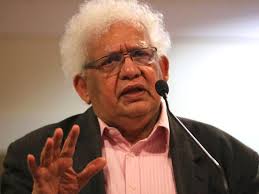By Meghnad Desai
Memories are short. Many people forget that the ubiquitous liberal free trade order is only around 25 years old. We can date its start to the aftermath of the fall of the Berlin wall and the break-up of the Soviet Union. The European Union’s single market started in 1993; the World Trade Organisation was set up in 1995.
What is in no doubt is that the (re)birth of a multipolar world is a reality. In a three-part series, I look at the US and Chinese roles in catalysing this transformation, the implications for different economies around the globe, why most of the changes we are witnessing were predictable, and why we should not necessarily fear them.
US President Donald Trump plays a big part in this. The liberal free trade system he is seeking to redefine was never as liberal as its champions claim, but it has defined the global order. The other pivot has been the military umbrella the US provides through the North Atlantic Treaty Organisation, formed in 1949, which Trump now appears to wish to dismantle.
The end of the 1945-1991 cold war and the WTO’s genesis made commentators call the 1990s ‘the end of history’. Western political and economic systems allegedly represented the conclusion of humanity’s sociocultural evolution, with the US as the sole superpower. It was never as simple as that. Many in the liberal order wished for a multipolar world. And this is what they have now got.
There are some piquant ironies here. When Chinese President Xi Jinping asserted his support for globalisation and free trade at the January 2017 Davos World Economic Forum, many European leaders hailed the rebuff to Trump’s assault on the modern liberal order.
China was championing free trade while not fulfilling the WTO’s conditions for qualification as a free market economy. China’s state subsidies are opaque. It blocks market access to outside investors, and it has a dubious record on protecting intellectual property rights. The EU, for its part, is a customs union that, by definition, does not practise free trade but is a protectionist agreement. Only the US is a practitioner of free trade, except in the case of farm products, where all countries are sinners.
Trump says the US can no longer afford to be the generous provider of such global public goods as Nato, the world trading system, and international sea lanes policed by the US navy.
In 1945, most economies were shattered after a decade of depression and then six years of world war. Most economies had been using tariffs and quotas to trade with each other, with Britain a relatively liberal outlier. The US led the postwar reconstruction of free trade, abandoning its high tariff policy of the previous 100 years and introducing a series of mutual tariff cuts under the 1947 General Agreement on Tariffs and Trade, with the Kennedy round in 1964 and Tokyo round in 1973 being the larger ones. These were mainly between developed countries. The Uruguay round, which began in 1986, included emerging markets as active participants, foreshadowing the WTO’s 1995 establishment.
In the beginning, protectionism was allowed for developing nations, just as European countries were permitted a common market and customs union, a major departure from free trade. With the signing of WTO, all were on the same level regarding permissible domestic trade policies. But, between 1945 and the mid-1990s, the shape of the global economy had changed.
During the cold war the US and Soviet Union competed on many fronts without engaging in direct conflict. The US fought a long proxy war against communism in Northeast Asia during the Korean war and later in Southeast Asia. Despite suffering major losses in both territories, the US repelled the challenge, driving the Soviet Union into dissolution.
But this was only part of the reshaping of the global economy. The US abandoned the gold-dollar link in 1971. Oil prices quadrupled in 1973. Innovations in satellite communications and shipping made it economical for manufacturing industries to shift from high-wage developed countries to Asia’s low-wage economies. Advanced economies moved up the value chain with successful high-tech and service sectors, especially financial services. Emerging economies in Asia began to industrialise rapidly and demanded access to developed economy markets during the 1986 Uruguay round – an attractive proposition for western companies. Consumers in developed economies benefited from lower manufacturing prices. The US accrued huge trade deficits as the world invested its savings in US Treasury securities.
Thus began the ‘Davos age’ of globalisation. However, along the way the manufacturing labour force in developed economies had shrunk, and the wages of low-skilled workers had stagnated. The financial sector made borrowing easier with subprime mortgages and similar innovations. For a while between 1995-2008, everyone was happy. But it couldn’t last. And it didn’t.
Lord (Meghnad) Desai is Emeritus Professor of Economics at the London School of Economics and Political Science, and Chair of the OMFIF Advisers Council.
This is the first in a series of three articles on the multipolar world and the impact of President Donald Trump on the modern liberal order of free trade and international relations. The second article will be published on 15 August.
Desai was among the relatively few international political commentators taking Trump seriously before the November 2016 presidential election.




